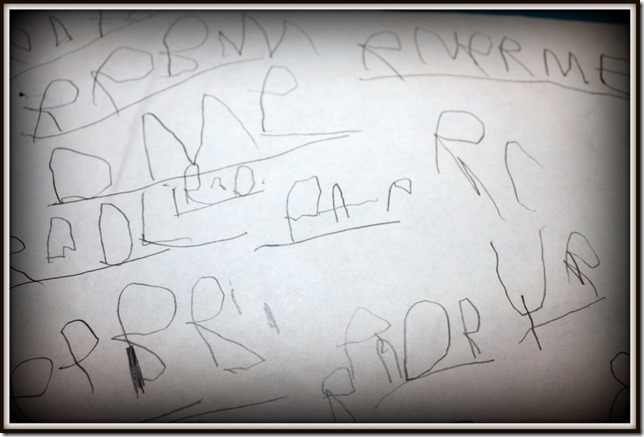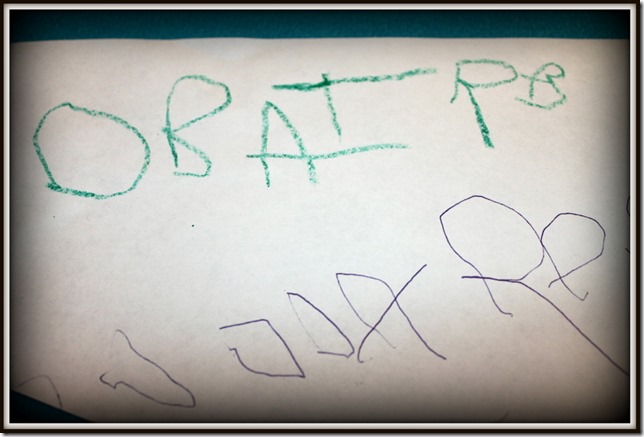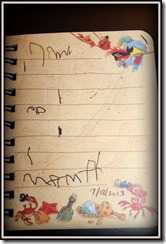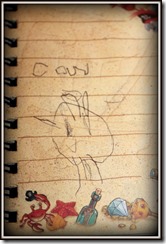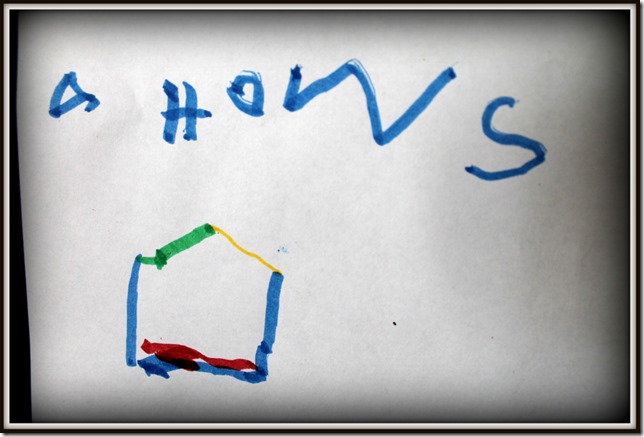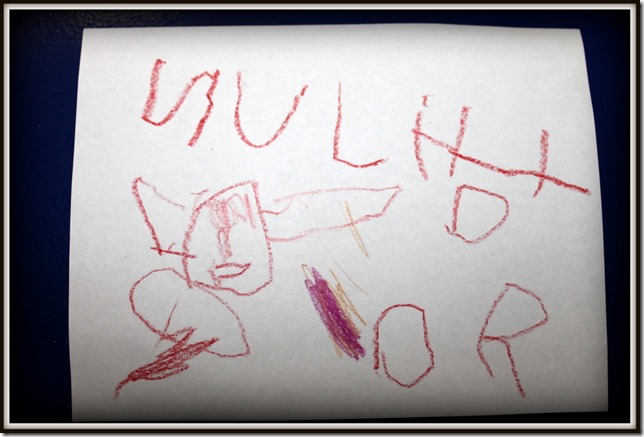My last post was about watching children learn the purposes of writing and finding their inner motivation to write. This happens through exposure to books and lots of reading with important adults in a child’s life. It also happens through exposure to writing materials: crayons, markers, colored pencils, different kinds of paper, staplers and tape to use for creating books, etc. Young children should be free to explore writing concepts without the expectation to produce a certain product or make their writing look just like someone else’s. Of course, as they develop as writers, they will work on letter formation, putting letters into words, and creating structured sentences. That comes after children understand the reasons for writing and after they have lots of time to explore concepts of print in a fun and self-motivated way.
So, that brings me to a discussion about how we learn to write. To really be a writer, you have to want to write. Very young children begin to notice their parents writing for a variety of purposes. They also see print all around them as they ride in the car, go to the grocery store, read books at home, and spend time with caregivers outside the home. Very young children can use crayons, paint, and paper to make their mark. There is a sense of accomplishment in knowing that your own movements in concert with a writing tool, can create interesting and varied marks. The exploration babies and toddlers experience in early writing/drawing exposures make those marks meaningful. I also love seeing toddlers with notebooks and pens/pencils just working away at their “writing”. These young children already know that their scribbles mean something and they are intent on their work.
When children begin to tell you that certain marks say something very specific, they are moving into a new phase of writing development. At this point, many children are also making attempts at writing their names. Young three-year-olds may write the first letter of their names and as they progress they add more and more letters. Mastering name writing gives children renewed confidence and at least a few letters they can write fairly easily. Children may use those letters over and over again on papers and in “books” they create. When they dictate a story back to you, it may not remotely match the letters on the paper, but the child is letting you know that he knows that letters in sequence have meaning. Exciting!!
My four-year-old son loves to write “stories”. He often dictates them to me and I write the words, but sometimes he writes the words and tells me what the words say. Until recently, the letters were random, as far as I could tell. Then, they started to shift. He often knows the initial letter sound and makes the printed letter match the oral sound. Other letters may or may not be accurate. He is beginning to make a move from letter practice to organized writing that shows a basic knowledge of the relationship between sounds and symbols. He asks us to spell words for him all the time and then spells words he sees and asks us what they say. I keep his little notebook in my purse and when we shop, he rides around in the cart and writes. I stretch words out for him and he writes the sounds he hears. We talk a lot about the sounds of letters as he writes. He is demonstrating the ability to transfer oral language to symbolic representations of these sounds. For this literacy nerd, it is thrilling to watch.
This is the same joy I feel when I see the children in my class really making those connections. In kindergarten, we work on letter-sound relationships and conventional spelling of sight word vocabulary. There are some words that children need to learn by sight because they are not easily decoded (sounded out). In writing, sight words also help children form sentences without frustration and they help the children maintain a flow in their writing. Children develop their own repertoire of conventionally spelled words too. Their names, names of their friends, Mama, Dad, love, zoo, yes, no, etc. may be on their lists. These are words that are important to them individually and appear frequently in their writing.
Writing and reading are very complementary skills. As children develop more advanced writing skills, they also develop skills as readers. Reading their own writing is a very motivational approach for helping children become readers. The more children experiment with writing, the more comfortable they become with the practice. Too often, we want children to practice writing something we impose on them. There is a time and place for that. However, when given freedom to write as they choose, they process and solidify skills in a way that is most meaningful for them.
Some ideas to encourage writing:
1. Turn off the TV.
2. Play with letters: magnets on the fridge, letter cutters in playdough, stencils, letter puzzles, etc.
3. Set up a writing/art table for your child. Provide easily accessible materials for your child to use as he/she chooses. I have different sizes and weights of paper, pencils, pens, glitter glue tubes, colored pencils, Stabilos, crayons, and a mini stapler for my son to use at his writing table.
4. Provide an easel for you child. Writing on a vertical surface can help a child with writing development. Get some dry erase markers and let your child just experiment and play.
5. Read, read, read together! You can never read too much. You need lots of books around you at home that provide choices for your child. Having a home library shows your child that books are important to you. An e-reader isn’t enough for young children. They need to hold a book in their hands and feel the pages, smell them, and form an emotional connection to that book.
6. Read the favorites over and over and over again! Just when you don’t think you can read one another time, your child may just pick it up and start reading it to you!
Finally, enjoy the literacy journey with your child. Reading and writing really do open up the world and create amazing possibilities.


